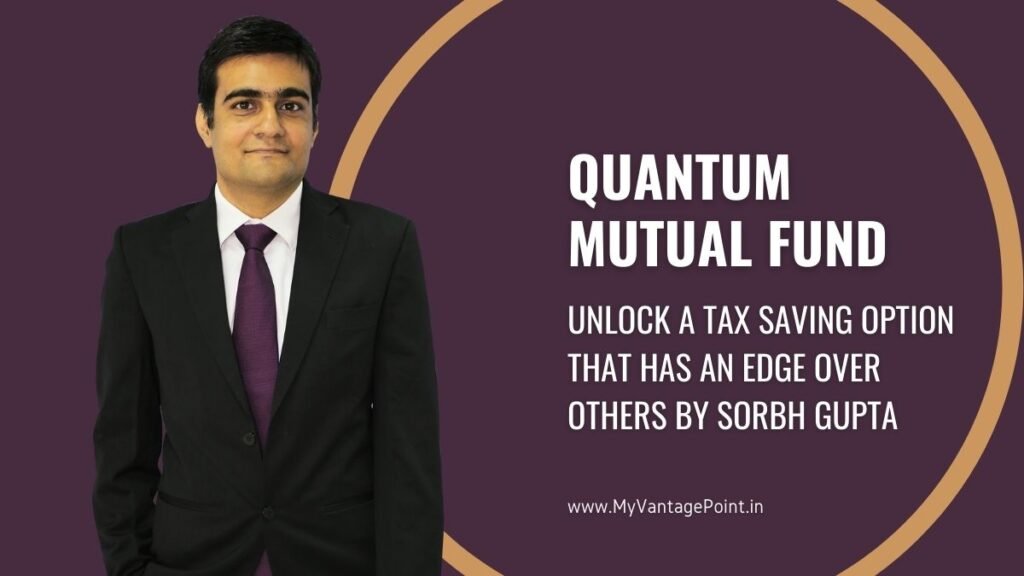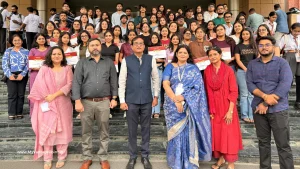Unlock a Tax Saving Option that has an edge over others by Sorbh Gupta. Quantum Mutual Fund
Webinar Rewind: Unlock a Tax Saving Option that has an edge over others with Quantum Mutual Fund

Given that the year is close to an end and the tax-saving season has started where people start looking at various options to save taxes. At this juncture, Sorbh Gupta, Fund Manager, Quantum Tax Saving Fund, discussed in our recently held webinar – how you can unlock a tax saving option that has an edge over others.
“Tax saving is an option given by the government under Section 80C, wherein you have multiple options like PPFs, Life Insurance, etc. In 2005, the Government allowed the launch of a mutual fund scheme category called the ELSS – Equity Linked Savings Scheme, which is like a typical equity mutual fund but has a lock-in for 3 years which as compared to other tax saving options under section 80C has the lowest lock-in period,” Sorbh said when he started his discussion around various Tax Saving avenues available.
Table of Contents
He later continued saying,
“Since it is an equity-oriented mutual fund under Section 80C, you can claim tax benefits up to Rs. 1.5 lacs and save based on the tax slab. This invested amount goes to pick decent stocks and tends to help in wealth creation over time. So, in a nutshell, you not only get upfront saving with immediate tax relief but can also create wealth over time with the investment in equity as equities have the potential to earn long-term risk-adjusted return.”
While equity does require a risk appetite and ELSS also has a 3yrs lock-in period, it is best suited for salaried or self-employed people who want to invest and save taxes. It is one of the most popular investment options for people in jobs who are looking to invest and save taxes under Section 80C.”
Sorbh went on to compare the edge ELSS has over traditional tax-saving instruments. ELSS has a shorter lock-in of only 3yrs.
“When it comes to investing, most people today don’t understand the benefits of long-term compounding capabilities of equity investing or the benefits of staying invested for a longer duration rather than exiting or moving. ELSS brings discipline in equity investing as it has a lock-in period of 3-year, and you can actually see the power of compounding enhancing in this duration. It can help you understand the benefits of staying invested and build in a culture of staying invested for a longer period.”
Sorbh discussed the ideal approach towards tax-saving,
“Most people look for tax saving options in February/March when their employer asks for investment declarations which is not the right approach. The best way to do an ELSS is to start somewhere in April with SIP so you can average out market movements and not compromise your returns. Most important is you need to keep in mind the orientation of the fund manager handling the fund and his philosophy. “
Speaking about churn ratio Sorbh added,
“Key to keep a track of the churn ratio of a fund is very important to see how the fund manager is handling the fund. A lower churn ratio indicates that the fund is being managed well, ideally, it should be below 20%. Also understand risks taken in the portfolio, whether invested in small-cap stocks which are more susceptible to effects of market turns downwards. Prefer to invest in a fund that follows a philosophy of Capital preservation over capital appreciation is very important.”
Sorbh later introduced Quantum Tax Saving Fund by saying,
“Quantum Tax Saving Fund is in the ELSS framework, value-oriented approach and works with a margin of safety. We have a dedicated research team who track different sectors to invest in and we invest for a longer period. Because of the low churn ratio, typically a stock will be in our portfolio for around 4 years. The Quantum Tax Saving Fund adopts a team approach that preserves philosophy if anyone fund manager leaves. No star fund manager approach is followed, to ensure consistency in the investing philosophy followed. This is especially critical for an ELSS fund since the fund has a lock-in period of 3 years.”
He continued, “What stand out for Quantum Tax Saving Fund is that we place higher importance on capital preservation over capital appreciation and over time we aim for capital appreciation as well. In the past, this investment approach has helped us generate reasonably good returns with very low standard deviation. This gives a lot of comfort to the investors.”
Sorbh went on to explain the trends in ELSS investments,
“While the demand is high during the January-March period, however, we at Quantum Mutual Fund are trying to change that and educate people to distribute their ELSS investment over a long period. We are seeing a keen interest of young investors (millennials) opting for SIPs in ELSS. The numbers are growing, and the average age of our investors is reducing every year, so there is definitely a shift, Sorbh asserted.
Sorbh continued, “We are seeing the keen interest of investors in ELSS vs other traditional tax-saving instruments; people now understand the importance of real rate of returns, inflation. People are getting more educated, and that is helping anchor thoughts of long-term investing with equities and mix that up with ELSS, it also helps save tax.”
As a concluding remark, Sorbh shared insights on how much should investors allocate their portfolio to ELSS, he explained
“May it be any financial goals like your child’s education, retirement, when you are investing your money for long-term, equity mutual funds are the ideal option, since they have to potential to provide long term risk and adjusted real return. A portion of that should be into ELSS. ELSS ideally should be linked to your financial goals. It is a way of investing in equities where one saves taxes as well. This allows the long-term creation of wealth with tax benefits. Investors should not consider ELSS as only a 3-year investment, but rather a part of your goals, part of your equity investing and that must continue regardless. Tax benefit may stop after the lock-in period, but the compounding of investments will continue as per change in markets. .”
Sorbh further added, “for retail investors, SIP is the best route for both ELSS and equity investment”
Disclaimer, Statutory Details & Risk Factors:
The views expressed here in this article / video are for general information and reading purpose only and do not constitute any guidelines and recommendations on any course of action to be followed by the reader. Quantum AMC / Quantum Mutual Fund is not guaranteeing / offering / communicating any indicative yield on investments made in the scheme(s). The views are not meant to serve as a professional guide / investment advice / intended to be an offer or solicitation for the purchase or sale of any financial product or instrument or mutual fund units for the reader. The article has been prepared on the basis of publicly available information, internally developed data and other sources believed to be reliable. Whilst no action has been solicited based upon the information provided herein, due care has been taken to ensure that the facts are accurate and views given are fair and reasonable as on date. Readers of this article should rely on information/data arising out of their own investigations and advised to seek independent professional advice and arrive at an informed decision before making any investments.
Risk Factors: Mutual Fund investments are subject to market risks, read all scheme-related documents carefully.
Read More
- Celebrating World Architecture Day: Designing Functional and Sustainable Spaces with REHAU Laminates

- Transforming Broken Tiles into Trendsetting Style, Somany Ceramics Collaborates with Amity University, Noida on World Architecture Day

- Percept Platinum Delivers a Flawless 2nd Edition of Sudha Reddy’s Pink Power Run 2025 in Hyderabad

- Jio Studios & B62 Studios Aim for a Hattrick with Dhurandhar After Article 370 and Dhoom Dhaam

- Katrina Kaif, Deepika Padukone to Diana Penty: Take Cues from THESE 7 Actresses to Rock Classy Aviators



















